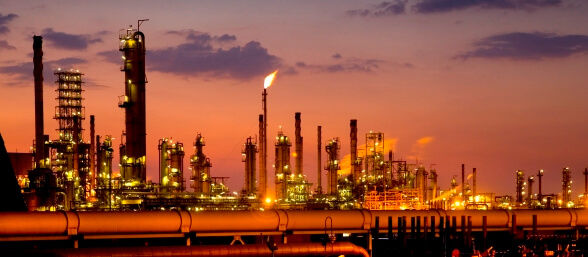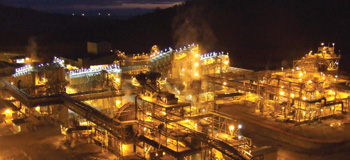Light fittings for use in Hazardous areas have the following characteristics. They are sealed to prevent the ingress of the liquid, gas or dust, lens for lamp, protection of a robust impact resistant material. They have a seal or machined face to ensure resistance to liquid, dust or gas, or a quenching flame path. Light fittings have different grades of protection depending on their construction and intended purpose. Some fittings are classified according to their IP Ingress Protection rating as it is designated.
What constitutes a hazardous area: in some contexts it could be a badly lit step, however, we consider it an area in which a flammable material, gas or vapour must be mixed in the correct proportion with air and within this mixture a spark or heat is present, sufficient to ignite the mixture. When Light fittings and other electrical apparatus are to be installed in a Hazardous Area it is essential that the decision maker takes measures to reduce the likelihood of an explosion by the correct selection of the equipment to be installed in that area. As the gases and vapours liable to be present are rated according to ignition temperature, Flash point and lower explosive limit, this information must be on hand when making your light fitting selection.


Gases also have a gas group classification, namely Group I, Group IIA, Group IIB and Group IIC, where Methane falls in the category Group I, while Hydrogen is a Group IIC gas, together with Acetylene.
The general classification of the area is then Zone 1 and 2 for gases and vapours and volatile liquids present in the air Zone 21 for combustible dusts, metallic and non-metallic and also fibres in suspension in the air Zone 22 dust and easily combustible fibres, not normally in suspension in the air, but are present in sufficient quantities to produce a combustible mixture.
A common fault of the light fitting purchaser is the non-specification of the gland type required for the installation which has to be compatible to the type of cable and the core diameters.
There are different glands available for steel armoured cable and for sheathed cables. Also cables should be of the flame retardant type if for exposed usage and if not sand covered.
Of the more common type of light fittings available for the Zone 1 situation are those designated and enclosed in:
i) Flameproof or explosion proof Ex "d" housings.
ii) Increased Safety Ex "e".
Although both are suitable for use in this type of atmosphere there is a world of difference in their construction format.
Before one considers the selection of the different types of protected equipment, we should first look at ways in which the dangers of a hazardous location can be reduced.
Wherever possible, electrical equipment should be situated in a ‘safe’ area, but only where this will lead to a reduction of the hazard. A good example is an electric motor situated in a Zone 1 or 2 location remotely controlled by a starter in a 'safe' location.
Explosion proof is used as a general term and relates to the various methods of protecting electrical apparatus for use in hazardous locations.
Flameproof or (Ex) d equipment is manufactured in such a way that it can withstand an internal ignition. Any gaps or 'flame path' in the enclosure are designed in such a way as to dissipate sufficient energy so that by then time the energy from the ignition reaches the outside of the enclosure, there is insufficient energy to ignite the surrounding flammable atmosphere. This means that the equipment needs to be heavy and hence expensive, comprising wide flanges on the mating machined surfaces and deeply threaded entries providing a labyrinth like flame-trap.
Type Ex s specially protected is designed and manufactured for special requirements and shall be accompanied by a test certificate issued by an ATL (Accredited Testing Laboratory) to prove it is safe.
The principle of intrinsically safe equipment is that both the voltage and the current are limited by means of an electronic circuit so that even under fault conditions, neither the voltage nor the current could ever exceed parameters that would allow an arc or spark large enough to ignite the inflammable atmosphere.
This type of apparatus separates the inflammable atmosphere from arcs, sparks or hot surfaces by pressurizing or purging the enclosures with air or an inert gas. The pressure inside the apparatus is kept above the ambient pressure outside.
In this type of protected electrical equipment, special precautions have been taken to prevent sparking, arcing and the occurrence of temperatures high enough to ignite a prescribed gas- or vapour-to-air mixture. A typical type ‘e’ piece of apparatus for use in a coal mine would have non-sparking cable terminal connections, be classified IP65 (dust tight) and be rated temperature class T1 (methane gas).
This apparatus is only used in Zone 2 locations where, in normal operation, it is not capable of igniting a surrounding explosive atmosphere and a fault capable of causing ignition is not likely to occur. As for increased safety type equipment, non-sparking apparatus is classified with IP and temperature class ratings.
This type of apparatus should be rated at least to a degree of protection IP65. This type of apparatus may be certified for use in atmospheres containing metallic and non-metallic dusts, or non-metallic dusts only, i.e. equipment approved for non-metallic dusts may not be used in atmospheres contaminated with metallic dusts.
GENERAL: Zone 0, Zone 1 and Zone 2 locations are those in which flammable gases or vapours are or may be present in the air in quantities sufficient to become hazardous.
These are locations in which flammable gases or vapours are continuously present in concentrations within the lower and upper limits of flammability.
NOTE: Such a condition is rarely encountered and is limited mainly to confined spaces (such as the vapour space of closed process vessels, closed tanks and closed containers), although it may also occur in larger rooms, such as rooms in chemical plants. Even in such spaces it is possible that the gas-air or vapour-air mixture is normally outside the flammability range.
These are locations:
a) in which hazardous concentrations of flammable gases or vapours occur intermittently or periodically under normal operating conditions, or
b) in which hazardous concentrations of flammable gases or vapours may occur frequently because of repair or maintenance operations or leakage, or
c) in which breakdown or faulty operation of equipment or processes, which release dangerous concentrations of flammable gases or vapours, might also cause simultaneous failure of electrical equipment.
NOTE: this classification usually includes locations where volatile flammable liquids or liquefied flammable gases are transferred from one container to another; interiors of spray booths and areas in the vicinity of spraying and painting operations where volatile flammable solvents are used; locations containing open tanks or vats of volatile flammable liquids; drying rooms or compartments for the evaporation of flammable solvents; locations containing fat or oil-extraction apparatus using volatile flammable solvents; portions of cleaning and drying plants where flammable liquids are used; gas generator rooms; inadequately ventilated pump rooms for flammable gases or for volatile flammable liquids and all other locations where hazardous concentrations of flammable vapours or gases may occur in the course of normal operations
These are locations in which operations concerned with flammable or explosive substances, gases, or vapours or volatile liquids are so well controlled that an explosive or ignitable concentration is only likely to occur under abnormal conditions.
NOTE 1: The following shall be regarded as the minimum requirements for a location to which this classification is applicable: a) The area is so well ventilated that, if abnormal conditions arise, ignitable concentrations of the gas or vapour are rapidly dispersed and their possible contact with electrical equipment is of minimum duration.
GENERAL: Zone 21 and 22 locations are those which are hazardous because of the presence of combustible dust and fibres.
NOTE: Locations that house only plant and machinery that become non-operative if they lose their dust-tightness or if their internal pressure ceases to be below atmospheric pressure and locations where combustible dust is stored in dust tight containers only, need not be classified. The classification of locations where dust is not normally in suspension in the air, but where mechanical failure or abnormal operation of machinery or equipment might cause suspension of dust and might also provide a simultaneous source of ignition through failure of electrical equipment, operation of protective devices, etc., depends on the specific circumstances.
These are locations:
a) in which, under normal operating conditions, non-conductive, combustible dust or fibre is (or is likely to be) in suspension in the air in quantities sufficient to produce an explosive or ignitable mixture,
b) in which metallic dusts may be present.
NOTE: This classification usually includes, for example, rooms containing machines (such as grinders, pulverisers, cleaners, graders and scrapers that are not provided with suitable dust extraction or exhaust systems, open bins and hoppers, terminal points of open conveyors and spouts in grain processing plants, starch plants, sugar plants, malting plants, hay plants and coal plants); and all working areas where metallic dusts and powders are produced, processed, handled, packed, or stored (except when these are stored in sealed containers).
These are locations in which combustible dust or fibre will not normally be in suspension in the air, or will not be likely to be thrown into suspension by the normal operation of equipment or apparatus, in quantities sufficient to produce an explosive or ignitable mixture, but where
a) Deposits or accumulations of such dust may be enough to interfere with the safe dissipation of heat from electrical apparatus, or
b) Deposits or accumulations of dust in, on, or in the vicinity of electrical apparatus might be ignited by arcs, sparks, or burning materials from such apparatus.
Since all hazardous substances can be ignited by a heated surface, these substances have been divided into various temperature classes.
Table below shows the various temperature classes with the corresponding maximum surface temperatures:
Temperature classes and maximum surface temperatures
Table below shows various gases divided into temperature classes and divided into gas groups:
| Temperature classes | |||||||
|---|---|---|---|---|---|---|---|
| T1 | T2 | T3 | T4 | T5 | T6 | ||
| Group | 1 | Methane | |||||
| 2A | Acetone Ammonia Benzene Carbon Monoxide Methanol Propane |
Ethyl-Alcohol n. Butane |
Petrol Diesel Aircraft Fuel |
Acetaldehyde | |||
| 2B | Town gas | Ethylene | |||||
| 2C | Hydrogen | Acetylene | Carbon Disulphide |
Ethyl Nitrate |
|||